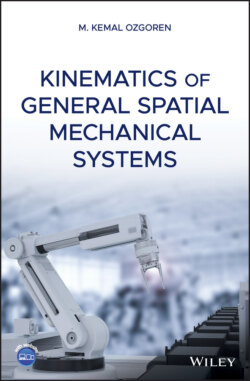Читать книгу Kinematics of General Spatial Mechanical Systems - M. Kemal Ozgoren - Страница 71
3.8.7 Commonly Used Euler Angle Sequences
Оглавление1 (a) RFB 1‐2‐3 Sequence
This sequence is generally known as a roll‐pitch‐yaw sequence. The angles of this sequence are generally named and denoted as roll angle (φ1 = φ), pitch angle (φ2 = θ), and yaw angle (φ3 = ψ). As such, the transformation matrix is formed as follows:
(3.106)
This sequence is not used very often with the general designations indicated above.
On the other hand, it is used quite often in the area of robotics especially for the purpose of describing the orientation of the end‐effector of a manipulator with respect to the base frame. However, when it is used for this purpose, it is designated differently as a yaw‐pitch‐roll sequence. The angles are also named and denoted differently as yaw or swing angle (φ1 = ψ), pitch or bent angle (φ2 = θ), and roll or twist angle (φ3 = φ). With these designations, the transformation matrix is formed differently as follows:
(3.107)
1 (b) RFB 3‐2‐1 Sequence
This sequence is generally known as a yaw‐pitch‐roll sequence. The angles of this sequence are conventionally named and denoted as yaw angle (φ1 = ψ), pitch angle (φ2 = θ), and roll angle (φ3 = φ). For this sequence, the transformation matrix is formed as follows:
(3.108)
This sequence is used very commonly in the area of vehicle dynamics in order to describe the orientations of all sorts of land, sea, and air vehicles with respect to selected reference frames.
1 (c) RFB 3‐1‐3 Sequence
This sequence is generally known as a precession‐nutation‐spin sequence. The angles of this sequence are conventionally named and denoted as precession angle (φ1 = φ), nutation angle (φ2 = θ), and spin angle (φ3 = ψ). For this sequence, the transformation matrix is formed as follows:
(3.109)
This sequence is used very commonly in the kinematic and dynamic studies that involve spinning bodies such as tops, rotors of gyroscopes, celestial bodies, etc. Actually, this is the sequence that was originally introduced by Leonhard Euler.
1 (d) RFB 3‐2‐3 Sequence
This sequence is sometimes used as an alternative to the 3‐1‐3 sequence in the studies involving spinning bodies. When it is used so, it is also designated as a precession‐nutation‐spin sequence. The angles of this sequence are then similarly named and denoted as precession angle (φ1 = φ), nutation angle (φ2 = θ), and spin angle (φ3 = ψ). In such a usage, the transformation matrix is formed as
(3.110)
This sequence is also used in the area of robotics as an alternative to the RFB 1‐2‐3 sequence in order to describe the orientation of an end‐effector with respect to the base frame. When it is used so, it is generally designated as a yaw‐declination‐roll sequence. The angles are then named and denoted as yaw or swing angle (φ1 = ψ), declination angle (φ2 = θ), and roll or twist angle (φ3 = φ). In such a usage, the transformation matrix is formed as follows:
(3.111)
